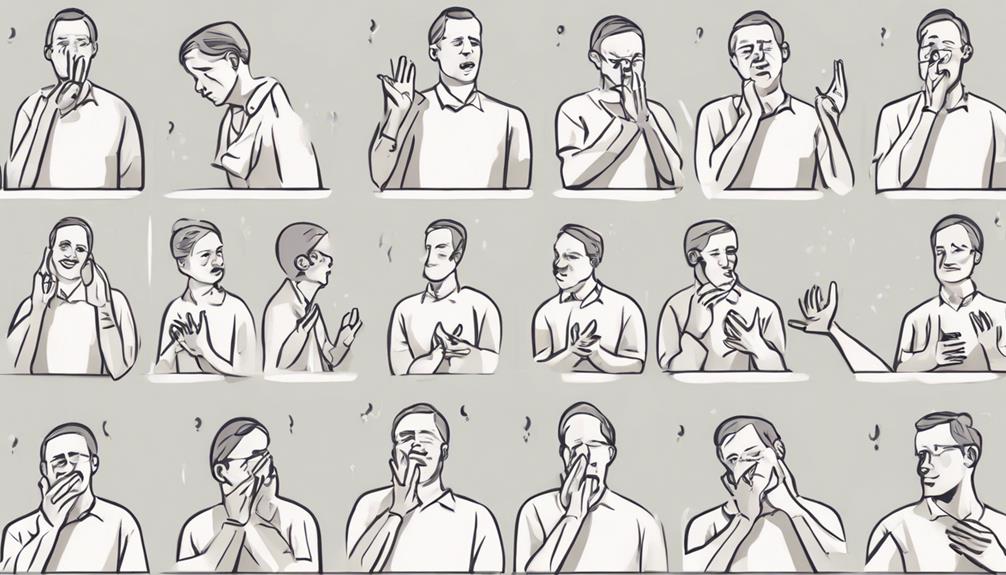Exploring covert hypnosis induction methods reveals intricate techniques for subconscious influence. From eye fixation to hypnotic storytelling, each method serves a unique purpose. Utilizing handshakes, embedded commands, and pattern interrupts establishes rapport and facilitates trance-like states. Hypnotic language patterns and mirroring techniques enhance influence on subconscious thoughts. Fractionation and non-verbal anchoring deepen suggestibility and trigger desired responses. By utilizing hypnotic triggers, subconscious responses are guided and suggestions planted. These top ten methods offer a comprehensive toolkit for those intrigued by the art of covert hypnosis.
Eye Fixation Technique

Utilizing the eye fixation technique is a method commonly employed in covert hypnosis induction to establish a deep connection with the subject through prolonged eye contact. This technique involves the hypnotist maintaining steady eye contact with the subject, which can create a sense of trust and intimacy, making the subject more susceptible to suggestion.
Subliminal messaging plays a crucial role in the eye fixation technique. While maintaining eye contact, subtle verbal cues or embedded messages can be delivered to the subject. These messages are often masked within normal conversation but are designed to bypass the conscious mind and influence the subconscious directly, enhancing the effectiveness of the hypnotic induction.
Furthermore, paying attention to body language cues is essential when using the eye fixation technique. Non-verbal cues such as facial expressions, posture, and gestures can provide valuable insights into the subject's mental and emotional state, allowing the hypnotist to adjust their approach accordingly and deepen the hypnotic connection.
Handshake Induction Method
Employing the handshake induction method is a strategic approach frequently utilized in covert hypnosis to establish rapport and initiate the hypnotic process. This method involves the hypnotist using subtle cues and secret signals during a handshake to induce a trance-like state in the subject without their conscious awareness.
During the handshake, the hypnotist may apply specific pressure or use a particular rhythm that acts as a trigger for the subject to enter into a hypnotic state. The handshake induction method relies on the power of suggestion and the subject's susceptibility to non-verbal cues.
Pattern Interrupt Approach

A common technique in covert hypnosis is the utilization of the pattern interrupt approach to disrupt the subject's typical thought processes and facilitate the induction of a hypnotic state. This method involves introducing a sudden change or unexpected element into the conversation or interaction, leading to a momentary confusion or distraction that opens the individual's subconscious to suggestion.
The goal of the pattern interrupt approach is to create a rapid induction into a hypnotic state by bypassing the conscious mind's critical faculty and directly engaging with the subconscious. By interrupting the individual's established patterns of thinking or behavior, the hypnotist can establish a moment of vulnerability where suggestions can be implanted more effectively.
Subconscious interruption is a key component of this technique, as it aims to access the deeper levels of the mind that are more receptive to influence. Through skillful implementation of pattern interrupts, a hypnotist can guide the subject into a state of heightened suggestibility and readiness to accept commands or suggestions.
This method is particularly effective for achieving rapid inductions and establishing a powerful hypnotic connection with the individual.
Embedded Commands Strategy
One effective technique in covert hypnosis involves strategically embedding commands within the conversation to influence the subject's subconscious mind. This strategy leverages subliminal messaging and persuasive communication to subtly direct the individual's thoughts and actions without their conscious awareness.
By integrating NLP techniques into the dialogue, the hypnotist can enhance the effectiveness of these embedded commands, tapping into the subject's subconscious influence more powerfully.
Embedded commands are carefully chosen words or phrases that are seamlessly woven into the conversation, often using tonal variations or subtle emphasis to make them stand out. For example, in a casual discussion, the hypnotist may say, 'You might find yourself feeling more relaxed as you continue to listen.' In this sentence, the embedded command is 'feeling more relaxed,' subtly prompting the subject to relax without overtly instructing them to do so.
Mastering the art of embedding commands requires finesse and practice, as the goal is to implant suggestions that bypass conscious resistance and directly influence the subconscious mind. Through skillful implementation, covert hypnotists can achieve profound results in guiding individuals towards desired outcomes.
Hypnotic Language Patterns

Utilizing hypnotic language patterns is a key aspect of covert hypnosis, enhancing the ability to influence individuals' subconscious thoughts and behaviors.
In covert hypnosis, power dynamics play a crucial role in establishing authority and influencing the target's mindset. By using persuasive language techniques such as presuppositions, ambiguity, and embedded commands, the hypnotist can subtly guide the individual's thoughts without their conscious awareness.
Power dynamics in hypnotic language patterns involve creating a sense of control and influence over the conversation, leading the individual to be more receptive to suggestions.
Persuasion techniques focus on subtly implanting ideas into the subconscious mind through language patterns that bypass critical thinking. These techniques are designed to influence behavior and beliefs without raising resistance or suspicion in the target.
Mastering hypnotic language patterns requires a deep understanding of how words can shape perception and trigger automatic responses, making it a potent tool for covert influence.
Mirroring and Matching Technique
The mirroring and matching technique is a pivotal element in covert hypnosis, facilitating the establishment of rapport and subconscious influence during interactions.
This method involves subtly mimicking the body language, gestures, tone of voice, and even breathing patterns of the person you are communicating with. By mirroring these behaviors, a sense of emotional resonance is created, leading to a deeper connection and rapport building between the individuals involved.
Through body language mirroring, individuals start to feel more comfortable and familiar with each other, often without consciously realizing why.
This technique taps into the subconscious mind, where much of our decision-making and emotional responses originate. By establishing a connection at this level, the hypnotist can subtly guide the direction of the interaction, influencing the thoughts and feelings of the other person without them being fully aware of it.
Fractionation Method

How can the fractionation method be effectively employed in covert hypnosis to deepen suggestibility and enhance subconscious influence?
Fractionation is a powerful technique used in hypnosis that involves repeatedly bringing an individual in and out of a trance state. By inducing a rapid induction and deep trance through this method, it allows for a heightened level of suggestibility and receptiveness to subliminal messaging.
This process of entering and exiting the hypnotic state multiple times within a session can lead to a deepening of the trance state with each cycle, making the individual more susceptible to psychological manipulation and suggestions.
Fractionation can be a potent tool in covert hypnosis as it enables the hypnotist to access the subconscious mind more effectively, allowing for the implantation of suggestions that can influence behavior, thoughts, and emotions. By utilizing this method strategically, hypnotists can create a profound impact on the individual's mindset and facilitate lasting changes through subtle yet powerful means.
Hypnotic Storytelling Approach
Employing a narrative-driven approach in covert hypnosis, known as the hypnotic storytelling approach, involves weaving compelling stories to induce a trance-like state and influence subconscious behavior. This method leverages persuasive narratives to subtly introduce subliminal messaging and psychological manipulation techniques into the listener's mind.
By engaging the individual in a captivating tale, the hypnotist can bypass conscious resistance and directly access the subconscious, where beliefs and behaviors are more easily influenced.
The hypnotic storytelling approach is designed to create a deep connection with the listener, allowing for the delivery of suggestions and commands that can shape their thoughts and actions. Through skillful storytelling, the hypnotist can implant ideas, desires, and motivations into the subconscious mind, leading to profound changes in behavior over time.
This method capitalizes on the power of storytelling to communicate on a deeper level, exploiting the nuances of language and emotion to exert subconscious influence covertly.
Non-Verbal Anchoring Method

Within covert hypnosis techniques, the Non-Verbal Anchoring Method involves utilizing subtle gestures, body language, and sensory stimuli to establish unconscious associations and trigger desired responses in the subject. Body language cues play a crucial role in this method, as they can convey confidence, trustworthiness, and authority, influencing the subject's perception of the hypnotist.
By employing specific gestures or postures consistently during the induction process, the hypnotist can anchor certain emotional triggers or states in the subject's mind.
Moreover, subliminal messaging through subtle movements or touches can further enhance the effectiveness of non-verbal anchoring. These subconscious signals can create powerful associations between the hypnotist's actions and the desired responses in the subject.
Through repeated exposure to these non-verbal cues, the subject's subconscious mind can be primed to respond automatically to the triggers established during the induction, leading to a deeper state of hypnosis and improved suggestibility. Mastering the Non-Verbal Anchoring Method requires precision and attentiveness to the subtle nuances of human communication.
Utilizing Hypnotic Triggers
The strategic application of hypnotic triggers is essential in guiding the subject's subconscious responses during covert hypnosis sessions. By incorporating subliminal messaging and subconscious influence through carefully chosen triggers, a hypnotist can effectively plant suggestions and influence behavior without the subject's conscious awareness.
These triggers can be sensory cues, words, gestures, or even specific objects that have been associated with certain responses through conditioning.
Incorporating persuasion tactics and mind control techniques, the hypnotist can create anchors that trigger desired responses in the subject. These triggers work on a subconscious level, bypassing critical thinking and rational processing to directly influence behavior.
Through the repetition and reinforcement of these triggers, the subject becomes more receptive to suggestions and commands, further deepening the hypnotic state.
Frequently Asked Questions
Can Covert Hypnosis Be Used for Unethical Purposes?
Covert hypnosis, when used unethically, can breach moral and legal boundaries. Employing manipulation tactics for malicious intent can have severe psychological impacts on individuals. Understanding the ethical considerations and legal implications is crucial in utilizing covert hypnosis responsibly.
How Long Does It Take to Master These Induction Methods?
Mastering covert hypnosis induction methods varies based on individual factors such as prior knowledge, practice commitment, and learning curve. Generally, proficiency can be achieved within a few months to a year with consistent practice and dedication.
Are There Any Risks Involved in Using Covert Hypnosis?
Ethical considerations are essential when employing covert hypnosis, as manipulating individuals without their awareness can lead to potential dangers. Legal implications may arise if used inappropriately, while psychological effects on both the subject and practitioner should be considered.
Can These Methods Be Effective in a Noisy Environment?
In a noisy environment, hypnosis effectiveness may be compromised due to distractions. Covert techniques require focus and concentration, making it challenging to achieve desired outcomes when external factors disrupt the process. Additional strategies may be necessary for success.
Is It Possible to Hypnotize Someone Without Their Knowledge?
Hypnotizing someone without their knowledge raises serious ethical boundaries as it can infringe on autonomy and consent. Additionally, the psychological effects of covert hypnosis without awareness may lead to potential harm and manipulation.
Conclusion
In conclusion, the 10 covert hypnosis induction methods discussed in this article offer a range of techniques for effectively guiding individuals into a hypnotic state.
Each method has its own unique approach and can be utilized in various situations to influence behavior and thinking.
By understanding and implementing these techniques with skill and precision, practitioners of covert hypnosis can enhance their ability to communicate and connect with others on a deeper level.


